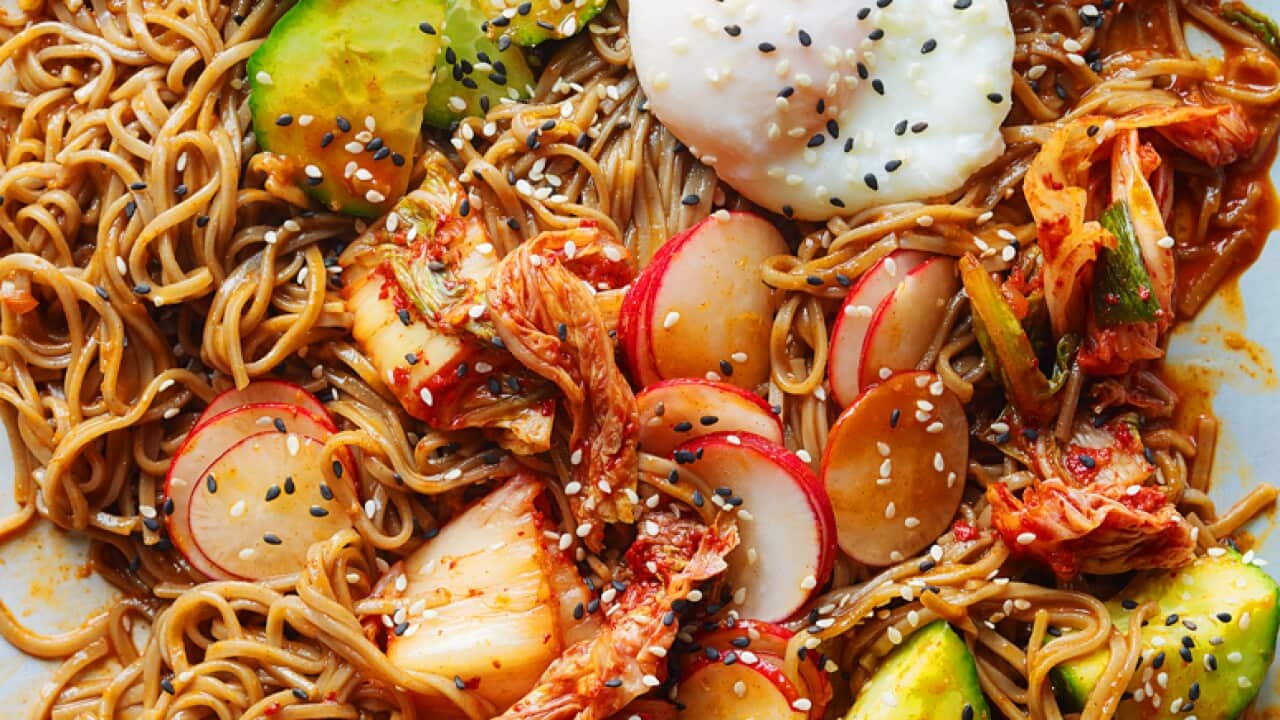Icy Korean naengmyeon (cold noodles) might seem like the perfect summer food, but they were traditionally a specialty enjoyed in the harsh winters of North Korea.
“Naengmyeonis now eaten all year round, but it’s supposed to be eaten in winter,” says Korean cookery expert Heather Jeong, who runs cooking classes at the Korean Culture Centre in Sydney. “You’ve got to remember that in Korea we’ve got heated floors, called ondol. It’s cold outdoors but because you’re sitting on this heated floor, your body is quite warm. It’s so warm that it’s nice to having something refreshing.”
These chewy buckwheat noodles traditionally sit in a broth made from meat stock and dongchimi (white radish kimchi water) that’s been partially frozen – think beer left in the freezer for just a little too long, but rescued before disaster. Served up in a metal bowl with icy condensation creeping up the sides, often topped with sliced cucumber, radish and a hard boiled egg, it’s almost impossible to imagine craving this dish on an icy night in Pyongyang, but that’s where it originates. Winter is when all the ingredients that go into this dish were at their most plentiful, after the autumn harvest, and dongchimiactually translates as winter kimchi. The broth is partially frozen simply because everything is during North Korean winters, including the earthenware pots that held the kimchi.
Winter is when all the ingredients that go into this dish were at their most plentiful, after the autumn harvest, and dongchimiactually translates as winter kimchi. The broth is partially frozen simply because everything is during North Korean winters, including the earthenware pots that held the kimchi.

Naengmyeon in Seoul - complete with icy slushie.
“They used to bury it underneath the ground, and sometimes it would just freeze over a little bit at the top, like a sorbet,” explains Heather.
The delicacy of naengmyeon travelled further south, and the tradition of an icy broth stuck, though there are now many different regional versions. “The naengmyeon in Pyongyang is considered an acquired taste because it’s quite bland. It was altered to a sweeter, icier and stronger taste further south,” says Heather.
Koreans across Australia will be craving these iced noodles all through winter, Heather included. If you’re shivering at the thought, it’s probably because of differing cultural approaches to eating for warmth.
While Western cultures tend to eat cool foods to cool down, and hot food to warm up, many Asian cultures follow the tradition of categorising particular foods as warming or cooling, and this can have no correlation to the temperature at which its served.
“The ingredients in making these noodles are supposed to quite warming to your body,” says Heather. “In fact, we eat samgyetang, a boiling pot of chicken soup, on the hottest day of the summer, because that’s supposed to keep your body cool. You’re supposed to eat something hot to keep cool, and vice versa.”
Zaru soba is a Japanese speciality of chilled soba noodles with a dipping sauce. Jugemu & Shimbashi restaurant in Sydney’s Neutral Bay specialises in handmade soba, and zaru soba remains a popular menu item during winter but mostly with customers from Asian backgrounds. “Right now in the restaurant I have a Japanese customer eating it cold, and a Western customer eating it hot,” says manager Ricky Murai, on the phone from his restaurant on a rainy, bleak night.
Zaru soba is eaten year round, but is considered to be at its best in the colder months, after the autumn harvest, when the fragrance and texture of buckwheat is at its peak.
“It’s also better to eat buckwheat noodles at cold temperatures, because if you have it in a hot soup it changes the flavour, the smell and texture,” says Ricky.
“Soba enthusiasts who particularly want to savour the texture and fragrance of the buckwheat will generally order the cold zaru soba,” says the restaurant’s soba chef, , but adds that a hot bowl of soba is not without its own charms.
If you’re keen to eat zaru soba in the winter but would also like something hot, Jugemu & Shimbashi can serve it to you with soba-yu, the hot water used to cook the noodles, on the side.
To try a bowl of naengmyeon on a cold day, head to your nearest Korean barbecue restaurant. “Most barbecue restaurants will serve it, it’s enjoyed at the end of Korean barbecue to clean your palate,” says Heather.
Throughout August, SBS Food is celebrating Asia's love of the noodle. Oodles of Noodles includes delicious new recipes, stories and tips for buying, cooking and storing noodles. Find out more .







